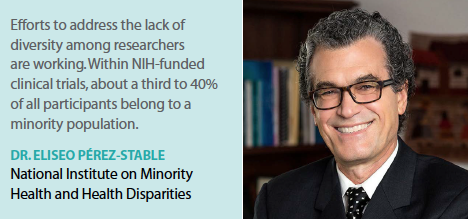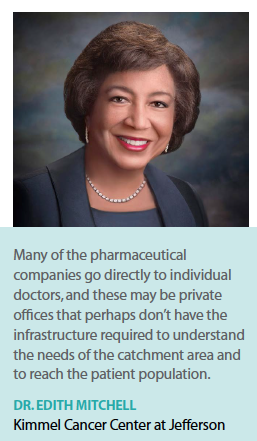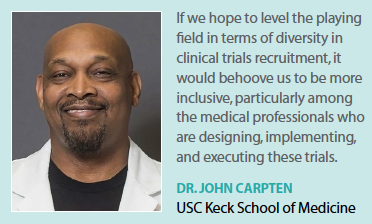Eliminating health disparities is an important public health issue, concerning all stakeholders. In oncology, for example, there are five cancers where disparities in adults have been identified: prostate cancer, breast cancer, colorectal cancer, hepatocellular carcinoma, and multiple myeloma. For example, in colon cancer, there is a 20% higher incidence of colon cancer in African Americans and a 40% higher mortality rate in these cancers occur at a younger age, with more aggressive tumors that tend to have metastasis at the time of diagnosis.
But there is a disconnect between the makeup of the population and diversity representation in clinical trials. African Americans, for example, comprise 13% of the population, but only 5% of clinical trial participants, while Hispanic patients represent 16% of the population, but just 1% of participants. Meanwhile, Caucasians account for 67% of the population and 83% of research participants.
Having a diverse patient population in clinical trials is important since medicines sometimes affect people differently  based on age, sex, and race. For example, ACE inhibitors for hypertension may have a different toxicity profile in African American patients, while African Americans with a certain common genetic variation require lower doses of the blood thinner warfarin compared with Caucasians. Mutations of the tyrosine kinase inhibitor EGFR are more common in the Asian population. Between 30% and 40% of Asians with non-small cell lung cancer have an EGFR mutation, compared with 10% to 15% of Caucasians.
based on age, sex, and race. For example, ACE inhibitors for hypertension may have a different toxicity profile in African American patients, while African Americans with a certain common genetic variation require lower doses of the blood thinner warfarin compared with Caucasians. Mutations of the tyrosine kinase inhibitor EGFR are more common in the Asian population. Between 30% and 40% of Asians with non-small cell lung cancer have an EGFR mutation, compared with 10% to 15% of Caucasians.
“No one has solid data as to the EGFR mutation frequency in African Americans or Hispanics," says Coleman Obasaju, M.D., Ph.D., a global leader for clinical diversity at Eli Lilly and Company. “In checking the literature there are a smattering of small studies, but we really don’t have robust information to be able to guide treatment decisions."
Another example in which an approved medication demonstrated different therapeutic effects on a distinct patient population not included as part of the trial is Plavix, a commonly used anti-platelet drug. About 50% of Asian patients and 75% of Pacific Islanders lack the enzymes required to activate the drug, data that was only uncovered after the drug was approved in 1997.
“Yet, the drug is marketed in Hawaii just like everywhere else," says Eliseo Pérez-Stable, M.D., director, National Institute on Minority Health and Health Disparities at the National Institutes of Health.
More recently, researchers from the Keck School of Medicine of the University of Southern California (USC)  Department of Translational Genomics analyzed a large-scale collection of publicly available data from the Multiple Myeloma Research Foundation (MMRF) CoMMpass Study. These researchers found that Caucasian patients’ cancers are more likely to have mutations associated with a worse prognosis. This same study, published in November 2017, also identified new cancer gene mutations that are significantly more prevalent in African Americans, linking these genes to multiple myeloma for the first time.
Department of Translational Genomics analyzed a large-scale collection of publicly available data from the Multiple Myeloma Research Foundation (MMRF) CoMMpass Study. These researchers found that Caucasian patients’ cancers are more likely to have mutations associated with a worse prognosis. This same study, published in November 2017, also identified new cancer gene mutations that are significantly more prevalent in African Americans, linking these genes to multiple myeloma for the first time.
Dr. Pérez-Stable says this type of information indicates that if diverse participants aren’t part of the clinical trial, there is the possibility to miss that something different might be going on.
There remain significant disparities in disease outcomes related to race and ethnicity, in many ways tied to socioeconomics and inequalities in the access to quality health care. And as John Carpten, Ph.D., co-director of the Translational Genomics Institute, USC Keck School of Medicine, explains, these factors often are intertwined.
“There have historically been lower rates of private insurance among African Americans and Latinos, compared with their counterparts of European descent," he says. “We see access of care issues as disparities in terms of race and ethnicity, and financial and socioeconomics issues tend to go hand in hand. To be honest, many disease disparities are examples of social injustice."
Industry experts say the racial and ethnic makeup of the trial population should match that of the disease. But an evaluation by the Food and Drug Administration of the new drugs approved in 2015 and 2016 shows that some groups, especially ethnic and racial groups, aren’t always well represented in clinical trials.
In 2016, CDER approved 22 novel drugs. Overall, 31,468 patients participated in these trials. Of these, 48% were women, 7% were African American, 11% were Asian, and 76% were white. In 2015, CDER approved 45 novel drugs.
Overall, 105,826 patients participated in these trials. Of these, 40% were women, 5% were African American, 12% were Asian, and 79% were white.
 The FDA also has released a report on global participation in clinical trials, which shows that trial participants for the drugs approved in 2015 and 2016 were mostly in non-U.S. sites, and 69% of the participants were outside the United States. Of the participants in trials of drugs approved in 2015 and 2016, 78.6% were white, 11.8% were Asian, 5.4% were black or African American, and 3.8% were listed as other.
The FDA also has released a report on global participation in clinical trials, which shows that trial participants for the drugs approved in 2015 and 2016 were mostly in non-U.S. sites, and 69% of the participants were outside the United States. Of the participants in trials of drugs approved in 2015 and 2016, 78.6% were white, 11.8% were Asian, 5.4% were black or African American, and 3.8% were listed as other.
For oncology therapies approved in 2015 and 2016, just 2.74% of trial participants were black or African American. In cardiovascular disease, just 2.5% of trial participants were black or African American, and 24.1% of trial participants for psychiatry drugs approved in 2015 and 2016 were black or African American.
Manfred Stapff, M.D., Ph.D., chief medical officer of TriNetX, says beyond disparity in terms of race and ethnicity, the complexity of study protocols is having a limiting effect on recruiting diverse patient populations.
“Study protocols have become so complicated over the past five to 10 years that eligibility criteria, for example, excluded laboratory values, and allowed comorbidities are not very representative anymore for the base population," he says. “This is beyond diversity in the sense of gender or race; we are also talking about diversity in the sense of comorbidities."
The continued move toward personalized medicine will also have an impact on the recruitment of diverse patient populations, says Jery Grupp, director of client relations, CRF Health.
“The variability stemming from hereditary components in genes is going to impact the response to medications," he says. “Sponsors need to have a broader cross sample of the world to conduct a trial effectively."
Clinical trials that are not aligned with the current disease state and real-world patient populations can result in significant bias in the results that are being used to make major decisions around future treatments, says Kathleen Mandziuk, VP, patient strategy, PRA Health Sciences.
 “Decisions around the safety and efficacy of future treatments or reimbursement have traditionally been made on information that would be limited to the perfect patients taking a treatment in the perfect way," she explains.
“Decisions around the safety and efficacy of future treatments or reimbursement have traditionally been made on information that would be limited to the perfect patients taking a treatment in the perfect way," she explains.
A lack of diversity in a clinical trial can affect the data and final outcome of the trial, says Kate Spencer, managing partner at Langland and lead for CTR at Publicis Health.
“Without diverse participation in clinical trials, health outcomes will not improve," she says. “Because some patient populations are more predisposed to certain diseases, trials must include diverse populations to demonstrate safety and effectiveness in the patients who will use the treatment."
The good news is that efforts to address the lack of diversity among researchers are working. Within NIH-funded clinical trials, about one-third to 40% of all participants belong to a minority population, Dr. Pérez-Stable says. This,  he says, is a cumulative effect of 25 years of policy that requires scientists to report the gender and race ethnicity of participants.
he says, is a cumulative effect of 25 years of policy that requires scientists to report the gender and race ethnicity of participants.
Additionally, the 21st Century Cures Act, passed in December 2016, contains measures to assess, report, and improve inclusion of key demographic groups, groups that reflect diversity of sex, age, and minority status. Specifically, the act encourages diversity by setting out a path for the NIH to continue and expand its efforts to address disparities in research.
The NIH launched the Institute on Minority Health and Health Disparities in September 2010, replacing the National Center on Minority Health and Health Disparities. This gave the institute a more defined role in the NIH’s research agenda against health disparities and authorized the NIMHD to plan, coordinate, review, and evaluate all minority health and health disparities occurring in research activities conducted and supported by the NIH institutes and centers.
“There are some disease areas where we lag behind, but overall things are moving in the right direction," Dr. Pérez-Stable says. “But the majority of trials are actually done outside NIH funding and funded by industry, where the information is not as transparent."
Barriers to Participation in Trials
Barriers that prevent minorities from participating with more frequency in clinical trials include a lack of awareness about clinical trials, education about what clinical research means, and a lack of ability to access trials, says Victoria (Vicky) DiBiaso, global head of clinical operations, strategy and collaboration within Sanofi’s R&D organization.
Several industry leaders mentioned there is also a lack of trust with the medical community, and the Tuskegee syphilis study continues to haunt many in the African American community. This was a 40-year study to evaluate untreated syphilis in African American men; participants weren’t provided treatment even after penicillin became available.
“This has created a lot of mistrust in the minority communities," Dr. Obasaju says. “There has to be process to build trust in the system; it can’t be something the industry dips its toe in one time. To drive trust, there needs to be consistent engagement and doing the right thing consistently over time."
Dr. Obasaju says minority communities want to be engaged. “They want collaboration; they want partnership," he says. “They want to be assured that we’re not just in it for profit."
According to a study in September by Zogby Analytics for Research!America and the Association of Clinical Research Organizations, efforts to address distrust with the industry appear to be working somewhat. African Americans reported an 11% decrease in lack of trust, while Asians, Hispanics, and non-Hispanic whites respectively reported 6%, 9%, and 15% decreases.
Strategies to Increase Diversity
Several people we spoke to noted that it will take increasing transparency to move the needle even further and resolve the remaining trust issues minority patients may have with the research community.
“Being more transparent by making all study results available is a good way to gain everybody’s full trust, which then also leads to people being more willing to participate in clinical trials," Dr. Stapff says.
The Research!America study suggests that clinical trials may be able to attract patients by appealing to their sense of altruism. African American and Hispanic patients in particular consider the opportunity to improve the lives of others when evaluating a trial.
Industry experts also say it is important to make sure site and study personnel are diverse. Dr. Carpten helped develop the African American Hereditary Prostate Cancer Study, which was conducted by the National Human Genome Research Institute. This large-scale genetic study to identify heritable causes of prostate cancer among African American men was conducted almost entirely by African American clinical investigators.
“We built a national network that included primarily African American urologists to work with African American men who were diagnosed with prostate cancer and their family members," he says. “They also worked with and hired nurse coordinators, many of whom were African Americans from the community, who could engage and communicate effectively with study participants. This approach has had a very strong impact on participants’ trust level. Trust is incredibly important in these settings. To move the needle, we need to be more open and inclusive in collaboration and the sharing of resources."
Lindsay McNair, M.D., chief medical officer at WIRB-Copernicus Group (WCG), says more institutions are appointing staff members who are focusing on diversity in recruiting for their clinical trials, conducting outreach to certain communities, and finding investigative sites that are located in certain communities.
“A diverse research staff that can talk to potential research participants in their language and who understand the cultural aspects that may apply can make a difference when it comes to increasing diverse representation in clinical trials," Dr. McNair says. “When we talk about increasing diversity in clinical research, we have to talk about not just the research subject, but increasing diversity in our research teams, the investigators, the coordinators, and making those populations more diverse also."
Several of our industry leaders mention that informatics and electronic medical records can also help to improve the disparities in clinical research.
Ms. Mandziuk says PRA has made significant investments in data and technology to assess how patients interact with healthcare options and is creating solutions for sponsors, sites, patients and study teams to think about recruitment in  a different way. This allows PRA to develop stakeholder engagement strategies to align with the incidence and prevalence of specific patient profiles.
a different way. This allows PRA to develop stakeholder engagement strategies to align with the incidence and prevalence of specific patient profiles.
“There is not a one-size-fits-all solution; we need to look at all of the different components when we design a strategy for a particular study to meet the scientific objectives and to reach a wider variety of patients to enhance the currently available evidence," she says.
Ms. Mandziuk says using real-world evidence, social engagement, and operational technologies can help find and engage patients that a typical KOL research institution may not have been able to reach in the past.
It’s important to have study sites that are based on demographics, says Peter Traber, M.D., CEO of Galectin Therapeutics. He points out that sponsors have to ask the right questions about patient populations as part of the site feasibility study.
“We need sites that can reach a broad base population," he says. “Sponsors have to communicate the importance of diversity in the clinical trial so that the sites that are chosen recognize the importance of diversity."
Mark Shapiro, senior VP of operations at Clinipace, says patient recruitment boils down to investigators who have a meaningful relationship with their patients.
“Patient recruitment is driven by how well investigators understand the treatment paradigms, how patients are diagnosed, how patients intersect with the healthcare system, how patients move through the system," he says.
“Investigators need to have a relationship with the patients who a sponsor wants to participate in a clinical trial."
Many cancer centers and related treatment sites are working hard to develop these relationships with communities and diverse populations. For example, the Sidney Kimmel Cancer Center at Jefferson has community navigators, providers or community advocates who live in the community to form partnerships with patients so that they can address specifically what the patients’ needs are, says Edith Mitchell, M.D., director of the Center to Eliminate Cancer Disparities and associate director for Diversity Affairs at the Sidney Kimmel Cancer Center at Jefferson.
This community connection, she says, helps the cancer centers understand and know the individuals and the socioeconomic problems that might exist in the catchment area and thus can address the community needs.
She recommends pharmaceutical companies also work with institutions that already have the infrastructure to conduct research; understand the community needs; understand the factors that influence participation in clinical trials in a given area; work with physicians and other providers; and understand medical insurance relationships.
Pharmaceutical companies recognize the need to recruit more diverse patient populations. For example, at Lilly, the company requires that for large studies — using at least 25 sites — that a minimum of two sites have to be “diverse disease sites," which the company defines as having at least 25% of its population as non-Caucasian.
“Our company has enforced this as a way to increase the enrollment of minorities in our bigger clinical trials," Dr.  Obasaju says. “After the initiation of this strategy we saw over time an improvement in the enrollment of African Americans and Hispanics to our clinical trials across the different disease areas — oncology, diabetes, and neuroscience."
Obasaju says. “After the initiation of this strategy we saw over time an improvement in the enrollment of African Americans and Hispanics to our clinical trials across the different disease areas — oncology, diabetes, and neuroscience."
Dr. Obasaju says to make this effort successful, the company committed to training minority investigators, and has engaged with more than 50 minority oncologists.
“In the United States today, according to the American Cancer Society census, we have about 10,400 medical oncologists, but out of this group only about 1% to 2% are African Americans and only about 2% to 3% are Hispanics," he says.
Lilly also has partnered with the National Medical Association, which represents African American physicians, the National Hispanic Medical Association, and the American Society of Clinical Oncology to leverage best practices.
“We have created a forum called the diverse site centers of excellence, whereby we reach out to stakeholders to have robust discussions around tactics that can be scaled up to have a bigger impact in the country," Dr. Obasaju says.
“There’s a need for collaboration between pharma companies, academia, advocacy groups, and all the societies to solve the problem of disparities in clinical research."
For Sanofi, having a diverse patient population in clinical trials is a key focus. The company engages the patient community directly to better understand how to remove barriers for participation. Ms. DiBiaso says the gaps in diversity in clinical trials at the company are narrowing. For the last five years, the company has seen a five-fold increase in the number of black or African American participants enrolling in Sanofi studies and a four-fold increase in Asians, as well as an increase in Hispanic participants on a global basis.
“We concentrate on diversity from the earliest beginnings of our clinical trial approach and strategy, from the countries where we will conduct the study down to the various towns and cities," Ms. DiBiaso says.
Partnerships with patient organizations also are now a mainstay in Sanofi’s development plans.
“This has transformed the way that we address drug development; we’ve moved away from the traditional model of developing medicines for patients and now we’re developing medicines with patients," Ms. DiBiaso says. “This is a fundamental shift. We think about the specific patient community for the disease under study."
Additionally, last year the company launched an online guide to understanding clinical research that sites and partner organizations can access when working with patients.
“People who are more informed about clinical trials generally express a higher desire to learn about study opportunities," she says. “We have found that there is a direct link between education and a willingness to participate in a clinical trial."(PV)
~~~~~~~~~~~~~~~~~~~~~~~~~
FDA Addresses Diversity
In 2016, then FDA Commissioner Robert Califf, M.D., declared that the year would be The Year of Diversity. In 2015, the agency launched Drug Trials Snapshots to give the public a view of demographic profile of the people participating in clinical trials for approved drugs.
An FDA spokesperson says the agency is continuing its efforts to promote the inclusion of underrepresented populations in clinical trials and has developed tools to support diverse clinical trial participation.
For example, the FDA hosted a meeting to update the public about progress in implementing the FDA Action Plan to enhance the collection and availability of demographic subgroup data. The FDA also issued two guidance documents —Collection of Race and Ethnicity Data in Clinical Trials and Evaluation and Reporting of Age, Race, and Ethnicity Data in Medical Device Clinical Studies — that provide clear and detailed guidance for regulated industry on matters related to clinical trial inclusion data.
Additionally, the FDA’s Office of Minority Health collaborated with the National Library of Medicine to help consumers and patients find clinical trials to conduct an ongoing multi-media Minorities in Clinical Trials campaign that encompasses public service announcements, educational materials, webinars, and print/digital outreach that highlight the importance of clinical trial participation. As part of the FDA’s Language Access Plan, the agency released multiple consumer information materials and updates in Spanish that describe why representation of minorities in clinical trials is important and how the FDA is working to increase participation.
~~~~~~~~~~~~~~~~~~~~~~~~~
Health Disparities — Yesterday, Today, and Tomorrow
Yesterday
By 1980, the average life expectancy in America had reached 74 years — 25 years longer than at the beginning of the 20th century. However, African Americans, Hispanic Americans, American Indians, Asian Americans, and Native Hawaiians/Other Pacific Islanders, who represented 25% of the U.S. population, continued to experience significant health disparities, including shorter life expectancy and higher rates of diabetes, cancer, heart disease, stroke, substance abuse, infant mortality, and low birth weight.
There was a growing awareness that racial and ethnic minority groups experienced poorer health compared with the overall population. Scientists believed that the disparities were a result of a complex interaction between factors such as biology and the environment, as well as specific behaviors that could not be meaningfully addressed due to a shortage of racial and ethnic minority health professionals, discrimination, and inequities in income, education, and access to healthcare.
In 2010, Congress stressed its commitment to health equity by elevating the National Center on Minority Health and Health Disparities (NCMHD) to the National Institute on Minority Health and Health Disparities (NIMHD). NIMHD leads the planning, review, coordination, and evaluation of NIH’s minority health and health disparities research activities.
Source: National Institutes of Health
Today
The NIH Health Disparities Strategic Plan and Budget is the national blueprint for research to eliminate health disparities and for the educational and outreach efforts needed to translate research advances to health improvements.
Current NIH priorities include: basic research focused on health disparities experienced by racial and ethnic minorities, the rural and urban poor, and other medically underserved populations; population-specific community-based participatory research; enhancing capacity to conduct health disparities research; recruiting and retaining racial and ethnic minorities and other underrepresented groups into the scientific research workforce; establishing health education programs for special populations; and promoting the inclusion of women, minorities, and other medically underserved groups in clinical trials.
Tomorrow
The Census Bureau predicts that racial and ethnic minority populations in the United States will grow to become half of the U.S. population in three decades. NIH has a research agenda in place to address the increasing health needs of racial and ethnic minorities, rural and urban poor, and other medically underserved populations in the midst of efforts to strengthen the healthcare system and improve access to care for millions of Americans.

















